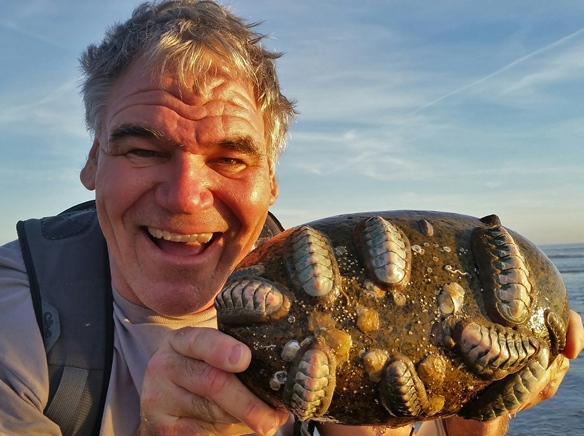
By Marty Golden
Chitons are marine mollusks that have been around since prehistoric times some 535 million years ago. Sometimes they are called coat-of-arms shells or suck-rocks. There are more than 900 species of chiton found world-wide, and most are less than 3 inches long, although the Giant Pacific Chiton can get to be about 13 inches in size. Also, remember, when you pronounce the word chiton that it rhymes with “tighten.”
Chitons have a shell made up of eight separate articulating shell plates. The plates provide protection and allow the animal to flex as it moves over uneven surfaces (see photo of my friend holding up a rock with eight chitons attached). Chitons live on or under rocks and other hard surfaces attaching to them with a foot, as we refer to the creature’s fleshy undersides.
Chitons lack an obvious head, but their tiny mouth can be seen on the underside of its front end. Look closely at the foot of an actual animal and you can see its gills along the outside edges. The edges of the shell plates are covered by a skirt made of a fleshy material called a girdle. Chitons can easily be identified based on the shape and color of their plates and girdles.
Tiny light sensing structures, typically around the skirt, help the chiton avoid predators. Some chitons even exhibit homing behaviors, as they can move around to feed and then return to the location they previously inhabited.
Typically chitons live in shallow water and are common in the intertidal zone (the near shore area that is covered and uncovered by tidal waters), but some species have been found as deep as 20,000 feet. Chitons are common on rocks and hard substrate at the Seal Beach National Wildlife Refuge as well as jetties and tide pools in the area.
While most chitons are herbivores that eat plant material, you can also find carnivorous chitons that eat animals and omnivorous chitons which will eat both plants and animals. Food items include things such as algae, diatoms, barnacles and bacteria that they eat by scraping the hard bottom with their radula. The radula is a tongue-like organ with rows of rigid teeth similar to a file, and it can be used to scrape or cut. Animals that prey on chitons include humans, birds, fish, crabs, lobsters and starfish. Many cultures around the world eat chitons including Native Americans of the Pacific coast.
If you are curious about chitons, I have a suggestion for you. Come on a tour of the Refuge or check the Cabrillo Marine Aquarium in San Pedro where you will find chiton shells in the Exhibit Hall case labeled Weed Eaters on Rocky Shores, then test your skill at identifying them in tide pools.
Marty Golden is a Marine Biologist with Friends of Seal Beach National Wildlife Refuge



